|
|
Mandane

|
|
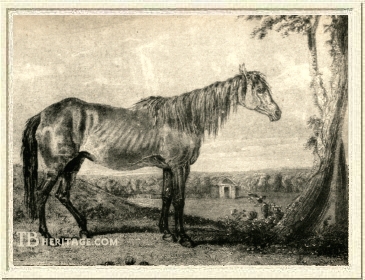 |
|
|
Mandane was one of the best broodmares of early nineteenth century. She spent her production years at the Yorkshire stud of Richard Watt, an influential racehorse breeder and owner who bred three Doncaster St. Leger winners and an Oaks winner, and many grand cup winners in the first decades of the nineteenth century. Two of his classic winners, Altisidora and Manuella, were daughters of Mandane. Most of Mandane's produce were winners, and they included the great stayer Lottery and Brutandorf, both of whom later sired winning stayers and sire sons. Her daughters were good producers, and can be seen as tail-female ancestresses in pedigrees today.
Mandane's dam, Young Camilla, was one of dozens of horses bred at George O'Brien Wyndham's (3rd Earl of Egremont) large stud at Petworth in Sussex, which produced five Derby winners and five Oaks winners between 1782 and 1820. Out of the Trentham daughter Camilla, also bred at Petworth, and by the good race horse and prolific and successful sire, Woodpecker, Young Camilla ran for several years; she was second to Young Mayfly in a sweepstakes at Newmarket in the fall of her juvenile year, beating the good racehorse Dragon. She was apparently sold to Newmarket trainer and owner Thomas Panton for whom she bred ten live foals, her best probably Mandane's brother, Enchanter (1799), who ran until age eight and beat the good horse Pipylin in a match at Newmarket when he was six. Mandane, her sixth live foal, was born in 1800.
|
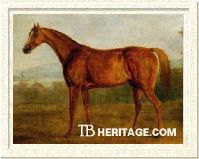
Pot-8-Os
| |
Mandane's sire was Pot-8-Os, a top racehorse and significant influence on thoroughbred breeding after he retired to stud at Richard (1st Earl) Grosvenor's Oxcroft Stud in Cambridgeshire. Among his sons were Waxy, who won the Derby in 1793, and later became the principal conduit of the Eclipse sire line, and Champion, the first horse to win both the Derby and the St. Leger. Pot-8-Os was also a good broodmare sire; among his many good daughters was Parasol (1800, from Prunella), who won 31 races and then produced two classic winners and the influential sire Partisan. |
Mandane on the Turf
Mandane, then, had the two best stallions of her time as sire -- Pot-8-Os -- and broodmare sire, Woodpecker. This great blood, however, was not much in evidence during her short racing career. Mandane ran twice at age two, being well beaten into fifth in a two year old race at Newmarket in July, and receiving a compromise payment of 25 guineas in a match scheduled against the colt Reptile at Newmarket in October. At age three she was little better, running third and last in a sweep stakes at Newmarket, and last in a sweep at Brighton. Carrying 7 more pounds, she won a small 50 guineas match at Brighton against the two year old Precipitate filly Lampedosa (later dam of Sherwood, second in the St. Leger to Barefoot), and on the same day was raced in a match against a four year old, Trinidada, which she lost, carrying a lot less weight (6 st. 6 lbs. to Trinidada's 10 st.). That was her last race in a brief and undistinguished career on the turf.
She was sold to Richard Watt, whose stud farm was at Bishop Burton in east Yorkshire. Watt was the third Richard Watt to live at Bishop Burton, the estate having been purchased by his grand-uncle Richard Watt (1751-1798), who was a stable boy and coach driver at the village inn, and made a fortune in rum and sugar, based on slave labor from a plantation he purchased in Jamaica after joining a merchant ship bound for the West Indies. He returned to England to purchase the Bishop Burton estate in the late 18th century. All three Watts owned and bred racehorses; but the Richard Watt (1786-1855) who owned Mandane was the most successful, breeding three St. Leger winners, his first being Mandane's daughter Altisidora, followed by Barefoot, and Memnon (Mandane's grandson from Manuella), and he purchased Rockingham, his fourth St. Leger winner, at age two.
Mandane in the Stud
Mandane had thirteen live foals, beginning in 1804, and almost all of those who made it to the races were stakes winners. Two daughters, Manuella and Altisidora, were classic winners and good producers. Her two best sons were Lottery, who won the Doncaster Cup and who continued the Tramp sire line, and Chester Cup winner Brutandorf.
Her first foal was Scratch, a filly by Whiskey, born in 1804, who was sold to a Mr. Hunter and sent to Ireland. Her next, Earnest, a bay colt of 1805, by Buzzard, died in the spring of 1809. Her third, a bay colt by Whiskey named Flip, born in 1807, was purchased by Charles Turner; he may have died before getting to the turf. She then produced a short-lived foal in 1808 by Trumpator. Her next youngster was the bay filly, Manuella, by Dick Andrews, born in 1809, who was sold to W.N.W. Hewitt, for whom she later won the Oaks. In 1810 Mandane dropped a full sister to Manuella, the chestnut Altisidora, who was retained by Watt, for whom she won the St. Leger.
In 1811 Mandane produced the bay filly Petuaria, by Orville, who was sold to Lord Cremorne and sent to Ireland; she failed to conceive to Orville the following year. In 1813, she produced the bay Captain Candid to Cerebus, and then missed to him in 1814; Captain Candid ran second in the St. Leger.
It wasn't until 1816 that she had her next youngster, the chestnut colt Procurante, by Langton, who won the Sapling Stakes at York. She was bred to Tramp in 1817, and aborted, and the following year missed to him, and in 1819 finally produced a live one, the bay filly Muta, in 1819, who won the Sapling Stakes and the Produce Stakes at York. Her next foal, born in 1820, was Lottery (first named Tinker), also by Tramp, later regarded as the best racehorse of his generation. In 1821 she foaled the future Chester Cup winner and sire Brutandorf, by Blacklock, and the following year dropped an unnamed bay filly by Whisker, who later became the dam of Liverpool (by Tramp, and therefore a close relative of Lottery's, and also related to Manuella and Altisidora). She was barren after the Whisker filly, although bred to Tramp in 1823 and 1824, and to Minos in 1825. Mandane died in 1826, shortly after she was deliniated by J.F. Herring (above), who had been commissioned by Watt to paint her daughter, Manuella (below), and Manuella's son, Memnon, late in 1825 after his St. Leger win. |
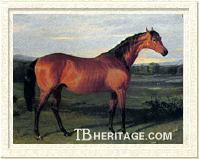
Manuella won the Oaks
| |
MANUELLA (1809, by Dick Andrews) was an elegant filly Watt sold to W.N.W. Hewitt. Her trials were very promising, and she entered the Derby as second favorite. She was deliberately pullled up by her jockey, Sam Chifney, Jr., in that race to lengthen the odds on her for the Oaks (thereby enhancing the value of his bet on her), to be run the following day, which she won handily, beating Pranks, Elizabeth and nine others. She ran unplaced in the St. Leger, won by Otterington, but a few days later won a sweepstakes held over the St. Leger course. In 1813 she ran third in a four mile cup at Preston. Sold to Lord Sackville, she also ran in 1814, beaten in a match race against Pericles at Newmarket. |
She returned to Bishop Burton as a broodmare, producing fifteen live foals, beginning in 1817. Her best offspring on the turf was her 1822 son, the bay colt Memnon, by Whisker. Memnon won the Champagne Stakes at Doncaster and a sweep at the same meeting at age 2, his only races that year. At age three, he won the the St. Leger of 1825, over the biggest field to that date -- thirty horses -- and then walked-over for the Gascoigne Stakes. Watt sold Memnon to Lord Darlington for £3,500; he won several races after that, including the Ascot Gold Cup in 1827, and placed second in several good races, including the Great Subscription Purse at York. He was retired to stud in 1828, after three outings, the best of which was a third in the Jockey Club Plate won by Chateau-Margeaux.
Manuella's 1823 son, the brown colt BELZONI, by Watt's stallion Blacklock, was a fair runner, but not top-class: as a juvenile in the north, he placed second to Bedlamite in a two-year old race at Doncaster, beating Mulatto. At age three, he won the York St. Leger, beating Bedlamite, and Mulatto, among others, but was not placed in the Doncaster St. Leger, won by Tarrare. At age four, he ran second in Newmarket's Trial Stakes to Pastime, beating Lamplighter, who later received a forfeit from him in a match at Newmarket in the fall. The following year he ran third in the Craven Stakes, won by Lamplighter. He later made a name for himself as a sire of hunters, and he got Vanguard, the winner of the 1843 Grand National Steeplechase at Aintree.
BELSHAZZAR (1830, out of Manuella by Blacklock), won a sweep for Watt for two year olds at Doncaster, beating a horse named Rockingham, owned by a Mr. Vanhisttart; after the race, Watt purchased Rockingham for £1,000, and the following year ran both colts in the St. Leger, which Rockingham won (Watt later sold Rockingham to William Theobald). Belshazaar, although he led for much of the race, ran unplaced. In 1834 Belshazaar ran fourth in Glaucus' Ascot Gold Cup, where he "proved himself a rogue and not to be trusted." In the stud, he sired 1839 1,000 Guineas winner Cara, the important broodmare Miss Lydia, and some other good horses; he was sent to the U.S. in 1838 where he became an influential sire.
Three of Manuella's daughters had a tail-female influence on thoroughbreds. Marginella (1826, by Whisker), was tail-female ancestress of Derby winner Kingston, of Oaks winner Sun Cap, of the American Triple Crown winner, War Admiral, of the good racehorse and sire Eight Thirty, and the French stakes winner and sire Zeddaan, to name a few. She was also tail-female ancestress of the great 'chaser of the early 1890s, Cloister, who won the Grand National in 1893. Another Manuella daughter, Nitocris (1829, by Whisker), who at age three won a £1525 produce sweep at York, and ran second for a Silver Tureen in a race at York, was tail-female ancestress of a number of really good horses, including Ascot specialist Fisherman (1853).
|

Altisidora won the St. Leger
| |
Mandane's daughter ALTISIDORA was an elegant chestnut filly by Dick Andrews, born in 1810. Put in training with "Old" Tommy Sykes near Malton, who trained most of Watt's horses, at age three she ran three times, winning a sweep at Malton for colts and fillies, and a 100 guineas race at York for colts and fillies, beating Camillus and three others, and running third in a sweep at York in August to Camillus and a filly by Hambletonian. She began her second season by winning a sweep for three year old fillies at York, and then won the Doncaster St. Leger over a field of fifteen after ten false starts. She followed that by winning a race for three year old fillies at Doncaster.
|
In 1814, age four, she easily won a 500 guineas match against Cameleopard, who ran second to her in the St. Leger, at York, over two miles. The same afternoon she beat the five year old Catton and two others over two miles. She took a walk over for the Club Stakes at Doncaster, and at the same meet, won a 100 guineas race over 4 miles, beating Cameleopard again. The following season she started by running second to Catton in a race over two miles at York, beating the good stayer Viscount. Also at York she won the Great Subscription Purse over four miles, but was then beaten by Catton in a race for the second Great Subscription. She went on to win the Fitzwilliam Stakes at Doncaster, and then ran second to Catton in the Doncaster Stakes, run immediately after Catton won the Doncaster Cup. The next day she won 100 guineas over four miles, beating the Orville filly Desdemona and Rodolpho. At Richmond she won a King's Plate over four miles; the last race of her career was the Richmond Cup, where she faltered badly, running seventh.
In the stud she was moderately successful, but none of her eight successive foals had anywhere near her own abilities, despite her breeding to some good sires, among them Rubens, Whisker, Blacklock, Catton and Walton. Almost all were sold by Watt to others, and most of them ran exclusively in the north. Her best offspring on the turf was probably Catiline, a chestnut colt of 1818 by Cerberus, who ran second in the four mile Great Subscription Purse at York in 1822. Another son, Abron (1820), by Whisker, was sold to a Mr. Russell. He won a sweep at York at age four (1824), beating his near relative Lottery, and then ran third to him in a King's Plate at York that same year; in 1825 he ran second to Lottery in the York Cup. 1826 he ran third in in the Stockton Cup, and third (and last) in the Newcastle Cup that same year. He was then sold to France. One of Altisidora's daughters, an unnamed filly by Blacklock, ran in the 1824 Doncaster St. Leger, but was unplaced. Her unnamed daughter by her old foe, Catton, produced Ralph, who won the 2,000 Guineas, the Ascot Gold Cup, the Cambridgeshire Stakes and the Criterion Stakes. In January of 1825 Altisidora fell into a ditch, and died struggling to get out. She was in foal to Watt's stallion Blacklock at the time. |
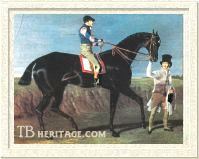
Lottery
| |
LOTTERY, by Tramp, was born in 1820. He was an attractive 16 hand high horse with a dubious temperament, aggravated by mismanagement. He won eleven races in his four seasons on the turf, and ran second seven times. He was a great stayer who won at distances up to four miles, his triumphs included the Doncaster Cup, Lincoln Cup and York Cup. Many considered him the best of his generation.
Retired to stud in Yorkshire, he became a source of stamina: he got one classic winner, Chorister, who won the St. Leger. His son Sheet Anchor, who continued the Tramp branch of the Eclipse sire line, had a brief career on the turf and at stud produced some good horses, mostly stayers.
|
Lottery's daughter, Rebecca, became the dam of the great racemare, Alice Hawthorn, who was the dam of Derby winner Thormanby, and who became the tail-female ancestress of many top stakes winners. Two of his daughters, Heads or Tails and Frolicsome Fanny, the dam of the good racemare Nina (dam of Planet), became influential in American pedigrees. Lottery was sold to France in 1834, where he got some good winners, and where his son Alteruter, also became a good sire after his exportation to France. Lottery also had an influence on steeplechasing bloodlines in England, France and Ireland.
Mandane's son, BRUTANDORF, was a bay colt of 1821. He was in the first crop by Blacklock, who had been purchased as a yearling by Watt, and who ran him exclusively in the north of England; Blacklock was the first horse Watt actually retained as a stallion for his stud.
|
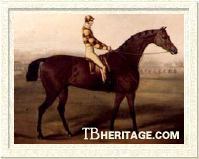
Brutandorf
| |
BRUTANDORF was sold to John Clifton of Lytham Hall, Lancashire, a long-time supporter of the northern turf. He won the Sapling Stakes at age three, and second to Canteen in the Gascoigne Stakes. He ran unplaced in the 1824 Doncaster St. Leger, won by Jerry, and the Doncaster Cup of that same year. In 1826, age five, he had some success, winning the Chester Cup, beating nine horses, and two days later winning the Stand Cup there, beating the good horse Longwaist by a short neck in an exciting race in which Longwaist's owner, Jack Mytton, lost £15,000. He also won the Tradesmen's Cup that year.
|
In the stud BRUTANDORF got Hetman Platoff (1836, from a Comus daughter), a fast horse of great courage and a good weight-carrier, who was owned by John Bowes of Streatlam Castle, Durham. At age three he won the Liverpool St. Leger, the Ayr Gold Cup, the Cups at Kelso and Dumfries, and four other races, and ran second in the Cambridgeshire Stakes Handicap. At age four, he won the Northumberland Plate, the Wolverhampton Stakes, and the Wolverhampton Cup, and walked-over for the Swinley Stakes at Ascot. His last race was the Leamington Stakes at Warwick, where he dead-heated with Glenlivit, falling lame, and was withdrawn from the second heat.
A Hetman Platoff son, Muscovite, won the Cesarewitch in 1854, and a grandson, Salpinctes (from his daughter May Bell), won the same race in 1865. Hetman Platoff's son, The Cossack (1844, from Priam daughter Joannina), a 15.2 hand chestnut with great speed, won the Newmarket Stakes at age two, and at age three won the Derby and ran second to Van Tromp in the Doncaster St. Leger. He went on to run until 1851, age seven, and in that time ran second for the Chester Cup, second for the Ascot Queen's Vase and third in the Ascot Gold Cup, and second and third for the Goodwood Cup in successive years. The Cossack was sent to stud in France. His son, Alcibiade was sent back to England to race as a three year old and was claimed in a selling race; he had never run in a steeplechase prior to his winning the Grand National in 1865 at age five.
Another BRUTANDORF son, Physician (1829), out of the Prime Minister daughter Primette, won several races at age three, including Doncaster's Scarborough Stakes, in which he beat Birdcatcher, the Stanley Stakes at Heaton Park, and the Gold Cup at Northallerton, and he ran second to Birdcatcher in the Liverpool St. Leger. At age four he won the Manchester Gold Cup, the Croxteth Stakes at Liverpool, and a Queen's Plate and a Silver Tureen in a race at York. In 1834, age five, he won the Stand Cup at Chester, a Queen's Plate at York, and ran second in the Liverpool Summer Cup. He stood at stud in England until 1842, when he was sent to France.
One of Physician's sons, Cure-All, won the Grand National Steeplechase in 1845. Another son, The Cure, won the Champagne Stakes and the Suffolk Stakes, and was later retired to Lord Airlie's stud, where he was deemed worthless as a sire and was put in training as a hunter, where he refused his fences. Sold to a doctor for seven shillings as a hack, the youngsters he bred for Airlie started to show some promise, including Lambton, a good steeplechaser, and he was resold for £250; eventually he was leased to the Royal Stud at Hampton Court, where some of his youngsters sold for over 1,000 guineas. In addition to Lambton, The Cure was the sire of Jealousy, a mare who won the Grand National Steeplechase in 1861.
Physician also sired Underhand, a fast stayer and good weight-carrier, who won Newcastle's Northumberland Plate three times, and ran second in it once, and who also won the Mostyn Stakes at Chester (age 2), the Manchester Cup (age 3), and the Great Ebor Handicap at York (age 5); one of Underhand's sons, Fervaques, won the Grand Prix de Paris in 1867. Of Physician's French offspring, Experience (1846 from Aspasie) won the Prix du Jockey Club in 1849, and Dulcamara (from Aspasaie) won the 1849 Grand Prix National (later Prix Gladiateur).
A half-bred son of BRUTANDORF'S, the gelded Gay Lad (1834), won the Grand National Steeplechase at Aintree. A Brutandorf daughter, Maid of Melrose (1829), was the dam of the game filly Blue Bonnet (by Touchstone), who won the Doncaster St. Leger in 1842.
Mandane in Jumper Pedigrees
Chart of her jumping descendants
Thirteen winners of the Grand National Steeplechase at Aintree descend from Mandane within six generations. She was grandam of two, the great Lottery, by her son, Lottery, and the half-bred Gaylad, by her son, Brutandorf.
|
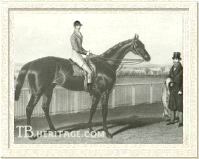
Grandson Lottery, by Lottery, winner of the first Grand National at Aintree
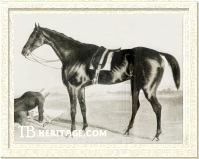
Grandson Gay Lad, by Brutandorf, won the Grand National in 1842
| |
Lottery sired the great steeplechaser, also named Lottery. Another Lottery son, Verulam, sired the mare Michaelmas Daisy (1845, out of Kiss by Waxy Pope). She was the dam of Revolver, who won steeplechases in Ireland and ran in the Grand National at Aintree. Revolver, in turn, sired Gamecock, winner of the Grand National in 1887, and a great many other good Irish jumpers. Michaelmas Daisy also produced a daughter, Dairymaid, whose son, Cortolvin, won the Grand National in 1867. Another Grand National winner, Grudon (Old Buck - Avis), who won in 1901, traced to Lottery through his sire, Old Buck: Old Buck's sire, Rococo (1863), was out of Rowena, whose dam, Rebecca (also dam of the great Alice Hawthorn), was by Lottery.
Lottery's son, Sheet Anchor, sired Collingwood, whose daughter, Polly Peachum (out of Craven Stakes and Goodwood Stakes winner Lucy Banks, by Elis), was the dam of the 1873 winner of the Grand National, Disturbance. Sheet Anchor's daughter, Yard Arm, produced a well-known hunter sire Gunboat, the sire of the great steeplechase mare Frigate (1878, Gunboat - Fair Maid of Kent), who ran second three times in the Grand National before winning in 1889.
|
Through Brutandorf (by Blacklock), Mandane was second dam of the half-bred Gaylad, who won the Grand National in 1842. Brutandorf's son, Physician, sired the 1845 Grand National winner Cure-All, and through his son The Cure, was grandsire of Jealousy, another mare who won the Grand National, this time in 1861. Brutandorf's son, the stayer Hetman Platoff, sired The Cossack, who in turn sired the French-bred 1865 Grand National winner Alcibiade; Hetman Platoff's daughter, Rackety Girl, who was sold to France, was grandam of the French-bred Reugny, who won the Grand National in 1874.
Mandane's daughter, Oaks winner Manuella (by Dick Andrews), produced, in addition to St. Leger winner Memnon, Belzoni, who became a good hunter sire, and who got the half-bred Vanguard, winner of the 1843 Grand National. The Ascetic son, Irish-bred Cloister, who ran second twice in the Grand National before winning in 1893, had two lines to Mandane through his dam; he descended tail-female from Manuella via her daughter Margelina, and he also descended from Brutandorf's daughter, Siberia.
-- by Patricia Erigero
|
|
|
|

